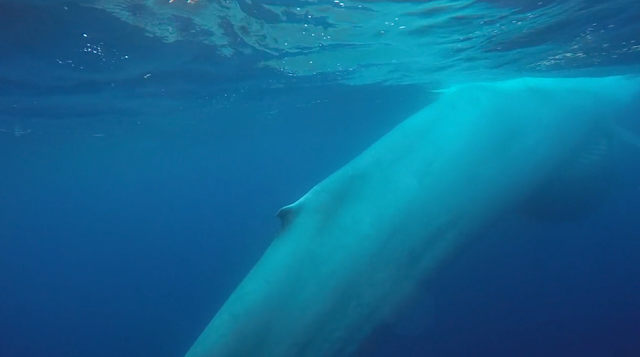The (not so) silent world
Le monde du silence (1956), co-directed by Jacques-Yves Cousteau and Louis Malle, filmed in the Mediterranean and Red seas, the Persian Gulf and the Indian Ocean, is an icon of underwater cinematography. The film faced strong criticism due to the environmental damage done during the filmmaking. However, far from discussing how environmentally conscious were Cousteau and Malle, we wish to discuss how silent this world truly was.
Pilot whales in the Southern coast of Pico island.
In fact, the ocean is a very noisy place. Ambient sound is an important aspect of the marine habitat, and noise in the ocean is the result of both natural –including geological and biological– and anthropogenic sources. These sources, when analysed together, provide insight into the acoustic scene. Today we are going to focus on the natural sources of marine sounds.
Natural sources of noise include processes such as earthquakes, wind-driven waves, rainfall, bubbles, bio-acoustic sound generation –eg. fish or snapping shrimps–, and thermal agitation of the seawater. Since underwater sound travels 6 times faster and 60 times further than it does through air, it is a good source of information of the environment, and a good tool for communicating. Hence, sound is critical to the survival of a great number of marine species: many marine species including invertebrates, fish and marine mammals produce sound in accordance with critical life functions—e.g., reproduction, communication, selection of habitat, territory defence, and foraging. Focusing on marine mammals, they use sound as a primary means for underwater communication and sensing.
Marine mammals –and specially cetaceans– produce sounds in a very complex composition. This sounds can be echolocation and clicks, pulsed sounds such as burst pulse sounds, tonal sounds such as whistles, and songs. Cetaceans use sounds for hunting, navigation and communication, including individual and group recognition, social cohesion and behaviour coordination or mate finding. Vocalisations are produced by some marine mammals to demonstrate annoyance, dominance, to ward off competitors, defend territories or guard females.*
This actively produced sounds have to he heard among the ambient noise. Ambient noise may fluctuate during the day, and the presence of a constant or chronic source is often interwoven with episodic sounds. For example, a study along the east coast of Australia, found that median ambient sound levels showed a consistent diel pattern with increased levels resulting from crepuscular fish choruses combined with a higher intensity of snapping shrimp snaps during those times. However, dolphin presence at night was greater than at any other time of the day. Moreover, singing humpback whales strongly influenced the overall sound levels throughout the winter migration, while other species of cetaceans were consistently detected, and others were seasonally detected only.
Geospatial features, such as bathymetry and bottom type as well as variation in water column stratification, also determine propagation of sounds. For example, shallow water marine environments present complex and dynamic blends of sounds and sonic relationships, and tides have an important role as natural sound modulators as sound levels correlate with the magnitude of tidal flow.
In conclusion, the ocean is not silent at all, and the collection of sounds present at a given location can reveal multiple dimensions of an ecosystem (biological, human, and physical) and present invaluable opportunities for understanding complex and changing ecosystems.
*You can watch a simulation here: https://www.instagram.com/p/CTfPJcejfSg/
Maria Serra
References
Hildebrand, J.A. (2009) Anthropogenic and natural sources of ambient noise in the ocean. Marine Mar Ecol Prog Ser 395, 5-20. https://doi.org/10.3354/meps08353
McCordic J.A., DeAngelis A.I., Kline L.R., et al. (2021) Biological Sound Sources Drive Soundscape Characteristics of Two Australian Marine Parks. Front. Mar. Sci. 8:669412. https://doi.org/10.3389/fmars.2021.669412
McKenna M.F., Baumann-Pickering S., Kok A.C.M., et al. (2021). Advancing the Interpretation of Shallow Water Marine Soundscapes. Front. Mar. Sci. 8:719258. https://doi.org/10.3389/fmars.2021.719258
National Oceanic and Atmospheric Administration [NOAA] (2016) Soundcheck: Ocean noise. NOAA National Marine Sanctuary Program https://www.noaa.gov/explainers/soundcheck-ocean-noise
Schall, E., Thomisch, K., Boebel, O. et al. (2021) Humpback whale song recordings suggest common feeding ground occupation by multiple populations. Sci Rep 11:18806. https://doi.org/10.1038/s41598-021-98295-z
Todd, V.L.G., Todd, I.B., Gardiner, J.C. and Morrin, C.N. (2015) Marine Mammal Observer and Passive Acoustic Monitoring Handbook. Exeter: Pelagic Publishing.
ZoBell, V.M., Frasier, K.E., Morten, J.A. et al. (2021) Underwater noise mitigation in the Santa Barbara Channel through incentive-based vessel speed reduction. Sci Rep 11:18391. https://doi.org/10.1038/s41598-021-96506-1






Comments
Post a Comment